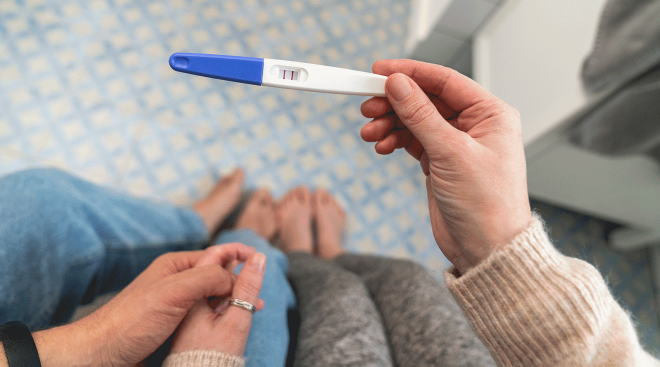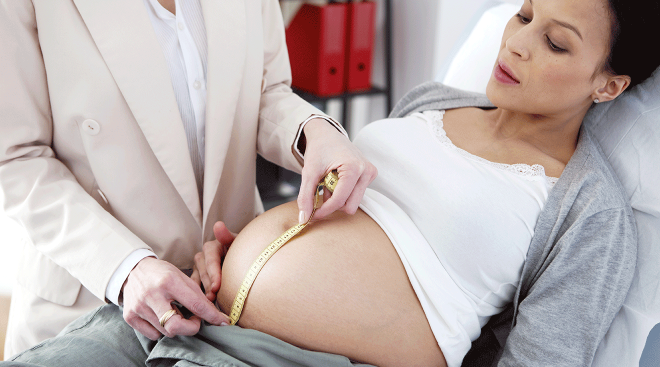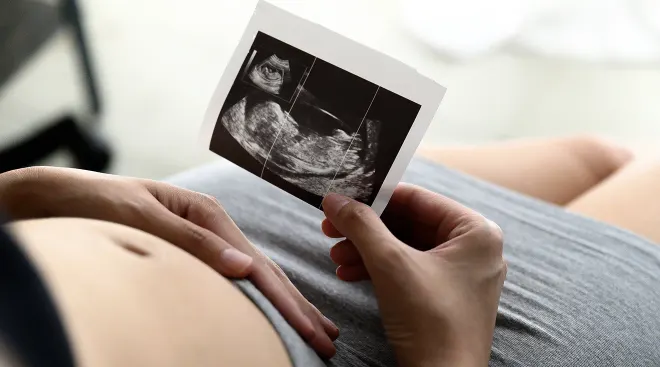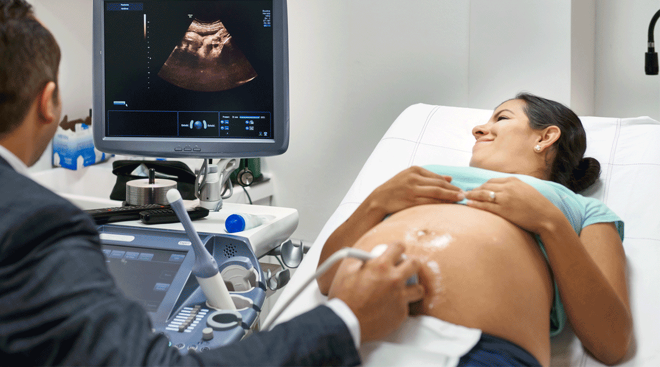Is a Cervix Check Always Necessary in Late Pregnancy?
You’ve got a lot on your plate in the final weeks of pregnancy. You might be sorting through all your baby shower gifts, the nesting phase could be kicking in and, of course, you’ve got doctors’ appointments on top of doctors’ appointments. During one of these visits, your provider might ask to perform a cervix check to see how close to labor you might be. Sometimes, this procedure is necessary, but that’s not always the case. If you’re uncomfortable during a cervical exam, you might wonder: Are cervix checks necessary? Ahead, find out what you need to know about cervix checking during pregnancy.
A cervix check, aka a cervical exam or pelvic exam, is done by your provider during pregnancy to assess the state of your cervix, which acts as a protective barrier between the vagina and the uterus, explains Skyler Jacobs, CNM, a certified nurse midwife with Modern Obstetrics and Gynecology of North Atlanta. “In labor, your cervix starts to change in its shape and consistency,” she explains.
A cervix check assesses factors such as dilation, which tells your provider how open the cervix is on a scale from 0 to 10 centimeters, and effacement, which describes how thin your cervix is: 0 percent means no thinning at all, and 100 percent means thin as paper. The thinner it is, the closer to labor you might be.
How is a cervix check done?
During the cervical exam, you’ll typically first be asked to lie down on an exam table and place your feet in stirrups, says Meleen Chuang, MD, medical director of women’s health at the Family Health Centers at NYU Langone. Usually the provider does the exam with a gloved hand, says Jacobs. In some cases, they might use a sterile speculum.
“The doctor may perform a manual examination by inserting one or two gloved, lubricated fingers into the vagina to check the size, position and texture of the cervix and for the fetal-presenting part,” says Chuang. “This allows them to assess the overall health of the reproductive organs.”
You might be curious: When will my OB start checking my cervix? “There’s no standard time at which [cervix checks] occur throughout pregnancy,” says Jacobs. You can ask your provider to perform the exam at any time. That said, cervix checks during pregnancy usually start toward the end of the third trimester.
Cervix checks during pregnancy
Cervix checks during pregnancy usually start around 36 or 37 weeks—earlier if you have unusual symptoms such as bleeding or contractions, says Chuang. Your provider might do tests such as the group B strep test along with the cervical exam, she adds.
Cervix checks during labor
If you’re planning on a vaginal delivery, your provider is likely to check your cervix during labor to assess how close you are to meeting baby—again, addressing factors such as dilation and effacement—says Chuang. “This information helps determine how far along a person is in labor and helps monitor the progress of labor,” she says.
You might have bleeding or other symptoms after a cervix check. These symptoms aren’t typically anything to worry about. Here are some symptoms you might experience after a cervical exam, and what to watch out for:
Bleeding after cervix check
Some people may experience light bleeding, which is typically normal, says Chuang. “However, if you’re experiencing severe pain, excessive bleeding or any other concerning symptoms, it’s always best to consult with a health-care professional for a proper evaluation,” she says.
Spotting after cervix check
Jacobs says that although spotting is common, “bright-red blood that is similar in flow to a menstrual cycle is not and should be reported to your provider promptly.”
Cramping after cervix check
“The cervix is a sensitive area, and the procedure itself can cause cramping or a brief sharp sensation,” says Chuang. Jacobs says that you might feel cramping because your cervix is particularly sensitive during this time.
Painful cervix check
Do cervix checks hurt? Chuang says it’s important to note that while cervix checks can be uncomfortable or slightly painful for some, the sensation is usually brief. If you notice any pain or other discomfort, always make sure to speak with your provider about your symptoms.
There are a few things you can do to ease discomfort, says Jacobs. “Practicing diaphragmatic breathing during these exams can help to decrease discomfort by lengthening and relaxing the muscles of the pelvic floor,” she says. “Placing both fists under your sacrum can also be helpful in cases where the cervix is posterior, or toward the spine.”
Your provider can also help minimize pain during the cervix check, says Chuang. “They can ask you to relax your buttock muscles and take a deep breath and breathe out slowly,” she says. “Copious lubrication and slow insertion helps to decrease discomfort.”
Has anyone gone into labor after cervical exam?
A cervical exam itself doesn’t directly cause labor, says Chuang. But a membrane sweep, which your provider might perform after 39 weeks to help get labor going, might, notes Jacobs. (After all, that’s generally the point.) The procedure starts with a cervix check, and involves your provider rotating their gloved fingers over the membranes that connect the amniotic sac and your uterus. “This process releases a hormone called prostaglandins, which can soften the cervix and initiate the labor cascade,” says Jacobs.
“The need and desire to have cervical exams performed may look different for every person,” says Jacobs. During a routine weekly visit during the last month of pregnancy, you might not need one if everything is going as planned. But there are scenarios when cervical exams become necessary, she says, including before a labor induction (whether elective or not) to “inform the medications and methods that would be received best,” to determine if you’re actually in labor and just before pushing to “ensure that the cervix is completely out of the way and no harm will be done to the tissue.”
If you’ve gone past your due date, your provider might use your Bishop score to track how close you are to labor and help determine whether you might need an induction, notes the Cleveland Clinic. That’s when your provider will perform a cervix check in order to assess characteristics including cervical dilation, cervical effacement, cervical consistency, cervical position and fetal station (how high or low baby is in the pelvis). “If the station doesn’t change over time, it may suggest a delay in labor progress,” says Chuang.
But while these factors are helpful, they won’t necessarily tell your provider when labor will start, notes Jacobs. “Although these exams help to identify the five characteristics of your cervix, they unfortunately don’t tell us much about when labor will start or how much longer labor will last,” she says. “In short, they’re informative but not predictive.” Therefore, it’s up to you and your individual provider to figure out whether a cervix check is necessary.
You always have the right to decline an exam if you don’t feel comfortable with it, or feel the exam isn’t necessary, says Chuang. Your provider should then explain risks, benefits and other options to you. If the cervix check won’t change your plan of care—for example, during those weekly visits—you can just tell your provider you’re not interested without further explanation, says Jacobs.
Jacobs says it’s important to speak with your provider if you have a circumstance that makes it difficult for you to undergo a cervical exam. “For patients who have a history of sexual assault or trauma surrounding cervical exams, this information should be communicated to their provider so together a plan can be established on how to best conduct these exams,” she says.
Finally, try to communicate your needs as much as possible. Your comfort is important, and your provider is here to answer questions and speak to concerns. “It’s important to have open communication with your health-care provider regarding cervical exams and their recommendations for your specific situation,” says Chuang. “They’ll be able to guide you on when and how often cervical checks are appropriate for you during your pregnancy.”
Please note: The Bump and the materials and information it contains are not intended to, and do not constitute, medical or other health advice or diagnosis and should not be used as such. You should always consult with a qualified physician or health professional about your specific circumstances.
Plus, more from The Bump:
Meleen Chuang, MD, is the medical director of women’s health at the Family Health Centers at NYU Langone. She earned her medical degree from Stony Brook University School of Medicine in Stony Brook, New York.
Skyler Jacobs, CNM, is a certified nurse midwife with Modern Obstetrics and Gynecology of North Atlanta practicing full-scope midwifery in the hospital and clinic setting. She is also the founder of Well & Worthy Co., where she passionately empowers expecting women through their pregnancy, birth and postpartum journey. Jacobs earned her master’s degree at Vanderbilt’s School of Nursing in Nashville, Tennessee.
Cleveland Clinic, Bishop Score, Oct. 2022
Learn how we ensure the accuracy of our content through our editorial and medical review process.
Navigate forward to interact with the calendar and select a date. Press the question mark key to get the keyboard shortcuts for changing dates.




















































